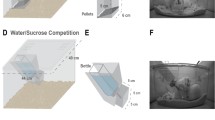Abstract
The social behavior of a colony of 9 male albino rats was recorded over a 5-week period. These observations were followed by a series of paired food competitions which yielded a standard laboratory measure of dominance. Each of these measures was correlated with every other measure. Factor analysis of the resulting correlation matrix revealed a cluster of closely related behaviors, including fighting, boxing, grooming, mounting, and total interactions. Food competition was not significantly related to any of the behavioral indices. These findings do provide a basis for a unidimensional dominance concept of some descriptive breadth and also raise questions concerning the relation between measures obtained via seminaturalistic observation vs those typically used in laboratory studies of dominance.
Similar content being viewed by others
References
BAENNINGER, L. P. 1966. The reliability of dominance orders in rats, Animal Behavior, 14, 367–371.
BAENNINGER, L. P. 1970. Social dominance orders in the rat: “Spontaneous,” food, and water competition, Journal of Comparative and Physiological Psychology, 71, 202–209.
BARNETT, S. A. 1963. The rat: A study in behavior. Chicago: Aldine.
BERNSTEIN, I. S. 1969. Stability of the status hierarchy in a pigtail monkey group (Maca nemistrina). Animal Behavior, 17, 452–458.
CALHOUN, J. B. 1963. The ecology and sociology of the Norway rat. Bethesda: U.S. Department of Health, Education & Welfare.
CALHOUN, J. B. 1967. Ecological factors in the development of behavioral anomalies. In J. Zubin (Ed.), Comparative Psychopathology. New York: Grune & Stratton.
CROOK, J. H. 1970. Social organization and the environment: Aspects of contemporary social ethology, Animal Behavior, 18, 197–209.
GARTLAN, J. S. 1968. Structure and function in primate society, Folia Primatologica, 8, 89–120.
GRANT, E. C. 1963. An analysis of the social behavior of the male laboratory rat, Behavior, 21, 260–281.
HAMILTON, C. L. 1960. Comparison of two methods of dominance testing in the monkey, Psychological Reports, 6, 247–250.
HOWELLS, G. N., & KISE, G. 1974. The measurement of social dominance in rats, The Psychological Record, 24, 101–108.
KERLINGER, F. N. 1973. Foundations of Behavioral Researc. (2nd ed.) New York: Holt, Rinehart & Winston.
KURTZ, K. H. 1965. Foundations of Psychological Research. Boston: Allyn & Bacon.
LINDZEY, G., MANOSEVITZ, M., & WINSTON, H. 1966. Social dominance in the mouse, Psychonomic Science, 5, 451–452.
MONROE, B. D. 1970. Influence of successful and unsuccessful social experiences on dominant-subordinate behavior of the rat, Developmental Psychology, 2, 359–363.
RUSKIN, R. S., & CORMAN, C. D. 1971. A multivariate study of competition in a free-operant situation, Psychonomic Science, 23, 251–252.
SCHJELDERUP-EBBE, T. 1922. Beitrage zur Biologie und Social-und Individual-psychologie bei Gallus domesticus. Griefswald, Germany: Adler.
SCOTT, J. P. & FREDERICKSON, E. 1951. The causes of fighting in mice and rats, Physiological Zoology, 24, 273–309.
SEWARD, J. P. 1945. Aggressive behavior in the rat. I. General characteristics: Age and sex differences, Journal of Comparative Psychology, 38, 175–197.
SYME, G. J. 1974. Competitive orders as measures of social dominance, Animal Behavior, 22, 931–940.
SYME, G. J., POLLARD, J.S., SYME, L. A., & REID, R. M. 1974. An analysis of the limited access measure of social dominance in rats, Animal Behavior, 22, 486 500.
UYENO, E. T. 1960. Hereditary and environmental aspects of dominance behavior in the albino rat, Journal of Comparative and Physiological Psychology, 53, 138–141.
VAN KREVALD, D. 1970. A selective review of dominance-subordination relations in animals, Genetic Psychology Monographs, 81, 143–173.
Author information
Authors and Affiliations
Additional information
We would like to thank Paul W. Sheppard and Pauline Masters for their help with the factor analysis. We also wish to thank Michael Harrison for his helpful criticisms of an earlier draft.
Rights and permissions
About this article
Cite this article
Drews, D.R., Wulczyn, F.H. Measuring Dominance in Rats. Psychol Rec 25, 573–581 (1975). https://doi.org/10.1007/BF03394349
Published:
Issue Date:
DOI: https://doi.org/10.1007/BF03394349




